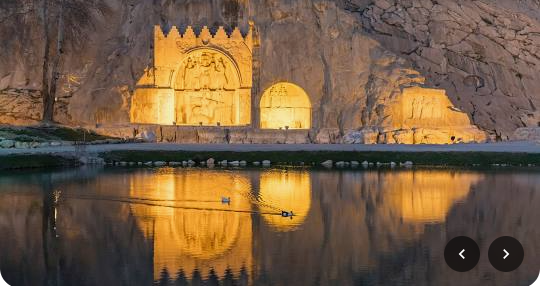

About Our City

About Kermanshah
Kermanshah province, with an area of 24,500 sq
meters, is located on the west of Iran and the city
of Kermanshah, being the ninth most populated city
of the country, is one of the metropolitan cities of
Iran. This province, with diverse climates and water
and soil resources, has a very high potential for
agricultural development, and its vast paints extend
across cold, temperate and tropical areas.
Weather:
geographically, Kermanshah province is a mountainous
region surrounded by Zagros Mountains. The height of
the mountainous areas of the province varies between
2000 meters to 3000 meters above sea level, and the
region has always had a healthy weather.
Nevertheless, during the recent years, the province
has encountered a new phenomenon called haze which
has led to numerous difficulties in peoples life and
created unfavorable climatologic and meteorological
problems.
Taq Bostan:
Taq Bostan is a historic complex consisting of
reliefs and inscriptions dating back to Sassanid
era, located on the north-west of Kermanshah.
Construction of this invaluable artistic and
historic complex began in the third century. In the
complex, there are some historic scenes such as
Khosro Parviz coronation, Ardeshir II Coronation,
and coronation of Shahpour II and Shahpour III , and
as well, several inscriptions in Pahlavi scripts.
Bisetoun:
Bisetoun inscription, from Achaemenid era, is
located 30 Km away from Kermanshah on the skirts of
Bisetoun Mount. This is one of the most important
and famous evidence of the world history and the
most important historic text of the Achaemenid
period in which the details of victory of Darius the
Great over Gyumat, a magus, and putting in chain of
insurgents have been demonstrated. As of the year
2006, this historic work has been listed as one of
the world heritage sites of UNESCO.
The takiyehs and most historic mosques of Kermanshah
date back to Qajar period and first Pahlavi Shah,
and the old architecture of the city, as well,
reflect the same period of Iranian history. Takiyeh
Moavenolmolk is the most famous work from Qajar
periods in the city of Kermanshah, the unique tiles
of which distinguishes it from other Takiyehs.
Souvenirs:
Candies: bezhi, nan-rowghani, nan-shekari,
nan-berenji, kak, Kermanshahi oil, and nan-khormaei
Handicrafts: gelim (short-napped coarse carpet),
giveh (light cotton summer shoes), jajum (coarse
loosely-woven woolen cloth), mowj (a woven wrapper
for bedclothes), various kinds of musical
instruments (daf, a kind of tambourin, tambourine,
tar, diwan, and setar), leather works
Meals:
tarkhineh, khuresh-khalalbadom, dandeh kebab,
Kermanshahi kebab, sibpolo, ash abbasali, and
Kermanshahi abgousht